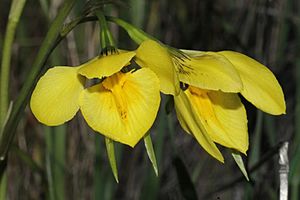Northern golden moths facts for kids
Quick facts for kids Northern golden moths |
|
|---|---|
 |
|
| Diuris protena in the Mount Jeffcott Nature Conservation Reserve | |
| Scientific classification | |
| Genus: |
Diuris
|
| Species: |
protena
|
The Diuris protena, also known as the northern golden moths, is a special type of orchid. It grows only in Victoria, Australia, meaning it is endemic there. This plant has a bunch of four to eight leaves at its base. It can grow up to three beautiful yellow flowers, often with some lighter marks. Sadly, this orchid is considered "endangered" in Victoria, meaning it's at risk of disappearing.
Contents
About the Northern Golden Moths Orchid
The northern golden moths orchid is a tuberous perennial herb. This means it has a fleshy underground stem (a tuber) and lives for more than two years. It grows between four and eight long, thin leaves. These leaves are about 70 to 120 millimeters (3 to 5 inches) long and 1 to 3 millimeters (0.04 to 0.12 inches) wide. They grow together in a loose clump, like a small bush.
What the Flowers Look Like
This orchid produces up to three flowers on a stem that stands about 120 to 200 millimeters (5 to 8 inches) tall. Each flower is about 15 to 25 millimeters (0.6 to 1 inch) wide. The flowers are mostly pale yellow. They might have a few light brown spots near the bottom of the top petal (called the dorsal sepal) and the special lower petal (called the labellum).
The top petal is held almost flat and looks like an egg. It is about 9 to 15 millimeters (0.35 to 0.6 inches) long and 3 to 8 millimeters (0.12 to 0.3 inches) wide. The side petals (called lateral sepals) are narrow and point downwards, staying parallel to each other. They are about 13 to 20 millimeters (0.5 to 0.8 inches) long.
The two main petals of the flower point forward. They have an egg-shaped part that is 7 to 15 millimeters (0.28 to 0.6 inches) long. This part sits on a greenish-brown stalk about 3 to 5 millimeters (0.12 to 0.2 inches) long.
The Labellum and Its Features
The labellum (the orchid's special lower petal) is about 10 to 18 millimeters (0.4 to 0.7 inches) long and has three parts, called lobes. The middle lobe is egg-shaped, about 7 to 14 millimeters (0.28 to 0.55 inches) long. The two side lobes are smaller, about 2 to 3.5 millimeters (0.08 to 0.14 inches) long.
At the base of the labellum, there are two broad, bumpy bumps called calli. These are important for the orchid's reproduction. The northern golden moths orchid usually flowers in August and September.
How it Got its Name
Discovery and Naming of Diuris protena
The Diuris protena orchid was officially described for the first time in 2006. A botanist named David Jones gave it its formal scientific name. He did this after studying a plant sample collected in 2004 from the Terrick Terrick National Park.
The second part of its scientific name, protena, is a Latin word. It means "before" or "forward." This name was chosen because this orchid flowers earlier than some other similar orchids.
Where it Lives and Grows
Habitat of the Northern Golden Moths Orchid
This orchid is found in specific areas of northern and north-western Victoria. You can find it in places between Donald, Terrick Terrick, and Elmore. It prefers to grow in the small remaining patches of Victoria’s native grasslands and open woodlands.
The biggest group of these orchids, with about 400 plants, was found in the Nardoo Hills Reserves. This area is managed by Bush Heritage Australia and is about 60 kilometers (37 miles) south-west of Terrick Terrick. Here, the orchids grow in yellow box woodland on the slopes of Mount Kerang.
Pollinators of the Orchid
Scientists believe that a type of native bee helps to pollinate this orchid. These bees also pollinate bulbine lilies, which are flowers that look similar in color and size to the orchid and grow in the same areas. This suggests a special connection between the orchid and these bees.
Protecting the Northern Golden Moths Orchid
Why the Orchid is Endangered
Sadly, most of the natural places where this orchid used to grow have been cleared for farming. The few remaining areas are now threatened by weed infestation. This means that unwanted plants are growing and taking over the orchid's space.
In 2007, experts estimated that there were only a few hundred of these plants left. Because of these threats, the northern golden moths orchid is listed as endangered. This listing is under Victoria’s Flora and Fauna Guarantee Act 1988. This law helps to protect plants and animals that are at high risk of disappearing forever.

